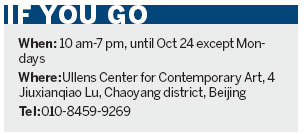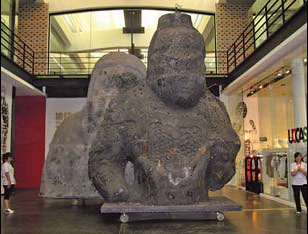Life and Leisure
Wrecked train spawns hope of living with environment
(China Daily)
Updated: 2010-10-05 08:46
 |
Large Medium Small |
|
|
Conceived and refurbished by artist Zhang Huan, Hope Tunnel - a giant work wrought from the train wreckage of the 2008 Wenchuan earthquake - is now installed at the Ullens Center for Contemporary Art (UCCA).
In the largest exhibition hall of UCCA, two wheelless carriages of freight train No 21043 are placed on crossties and railroad tracks, parts scattered around. A few beams of light from the ceiling make this rusted train appear larger than life, but lifeless against the white wall.
A documentary that follows every step of the train's journey - from a salvage company in Xi'an of Shaanxi province to Zhang's workshop in Shanghai, to UCCA in Beijing - is played in the hall.
Hope Tunnel is a social project of UCCA that urges people to confront the way humans clash with or compromise with the environment, which the artist believes can galvanize people into positive action.
According to the artist, the train is the "witness to history. Reflecting on the disaster, investigating the causes, mitigating future dangers and finding ways to live in harmony with our environment rather than trying to conquer it - that's where the real future is, the tunnel of hope that leads to tomorrow."
The project aims to inspire philanthropy. One third of the 15 yuan ($2.24) fare will go to the Red Cross Society to fund disaster relief and reconstruction projects in Wenchuan, Sichuan province; and Yushu, Qinghai province.
On May 12, 2008, freight train No 21043 on the Baoji-Chengdu Railway, loaded with over 600 tons of grain and 12 tanks of aviation fuel, collided with a massive boulder displaced by the quake and derailed.
"The Earth's sudden outpouring of fury buried both a loaded freight train and the arrogant idea that human beings can somehow conquer the forces of nature," says Zheng Yan, director of the art department of UCCA.
After buying the train from a salvage company, Zhang Huan and his team spent two weeks transporting the two sections from Xi'an back to his workshop in Shanghai.
It took another half-year to renovate the sections and conceive the exhibition form.

When the exhibition ends on Oct 24, Zhang Huan intends to auction the work. Part of the auction proceeds will go to quake zones in Sichuan, the rest to charity organizations.
Over the same period of the exhibition, two of Zhang Huan's large incense-ash sculptures, Military Officer and Cultural Officer, are displayed in the UCCA lobby. Incense ash used on the oversize sculptures was collected from some 20 temples in and around Shanghai. It was sorted and mixed with a binding agent and then molded into various shapes.
The 45-year-old artist was born in Anyang, Henan province. Currently he lives and works in Shanghai, and his works explore the relationship between nature and human beings.
The gallery is also currently holding three other exhibitions currently.
Centered on the themes of "invisible" violence and confrontation, Yang Shaobin's Blue Room will transform the gallery's Middle Room into a monochromatic sea of true-blue landscapes and portraits inspired by global climate change.
From Where There is No Return is a selection of 80 photographs from the celebrated Spanish photographer Alberto Garca-Alix's project, De Donde No Se Vuelve. It records scenes from life in Madrid, Paris and Beijing.
White Cube & Black Box will present a group of "breathing" sculptures in the form of household items, by Wang Yuyang, together with a documentary of Hu Xiangqian's 15-day-adventures in the wild, Survival Guide.
